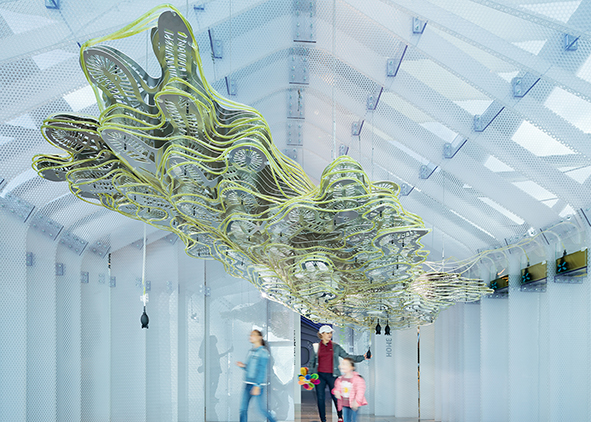La seconda vita dei micro organismi. Il design biodigitale per una nuova ecologia dello spazio e del comportamento
DOI:
https://doi.org/10.19229/2464-9309/942021Parole chiave:
design sistemico, design biodigitale, design ricostituente, biotecnologia, dark ecologyAbstract
Riflettere oggi, in qualità di progettisti e di ricercatori, sul tema della Seconda Vita significa porsi non soltanto domande circa le possibili declinazioni contemporanee di questo termine all’interno di un campo disciplinare definito da saperi che intrecciano ambiti quali l’Urbanistica, l’Architettura, gli Interni e il Design, ma anche esplorare il concetto stesso di vita rendendo gli organismi viventi, umani e non, parte attiva della speculazione e delle eventuali sperimentazioni dando nuovo significato ad azioni come la rigenerazione o il riuso. Per farlo, è necessario ampliare il raggio di intervento e coinvolgere altre discipline come la biologia e l’informatica, ma anche la filosofia, l’antropologia e molte altre. Esempio di questa pratica è il design sistemico, un metodo definito dalla combinazione e integrazione di pensiero sistemico, design computazionale, biotecnologia e prototipazione. Si tratta di un approccio allargato del design – che spazia dal micro al macro – incorporato in applicazioni dove i progetti e le installazioni diventano laboratori interattivi basati sulla collaborazione interspecie. Testimonianza di questo approccio è il lavoro svolto da una realtà multidisciplinare come ecoLogicStudio, attraverso la teoria e la pratica.
Downloads
##plugins.generic.articleMetricsGraph.articlePageHeading##
Riferimenti bibliografici
Antonelli, P. and Tannir A. (eds) (2019), Broken Nature – XXII Triennale di Milano, Electa, Milano.
Ballocchi, A. (2018), “Biologia e digitale – L’architettura di domani passa da qui”, in Wise Society, 16/02/2018. [Online] Available at: wisesociety.it/architettura-e-design/biologia-digitale-architettura-pasquero/ [Accessed 15 May 2021].
Bateson, G. (1977), Verso un’ecologia della mente [or. ed. Steps to an Ecology of Mind, 1972], Adelphi, Milano.
Bullivant, L. (2012), New Arcadians – Emerging UK Architects, Merrell Publishers Limited, London.
Morton, T. (2019a), Cosa sosteniamo?, Aboca, San Sepolcro.
Morton, T. (2019b), Come un’ombra dal futuro – Per un nuovo pensiero ecologico, Aboca, San Sepolcro (AR).
Nicoletti, G. (2008), “La resurrezione della carne”, in Domus, n. 910, pp. 78, 79.
Otto, F. (2008), Occupying and Connecting – Thoughts on Territories and Sphere of Influence with Particular Reference to Human Settlement, Axel Menges, Stuttgart.

##submission.downloads##
Pubblicato
Come citare
Fascicolo
Sezione
Licenza
AGATHÓN è pubblicata sotto la licenza Creative Commons Attribution License 4.0 (CC-BY).
License scheme | Legal code
Questa licenza consente a chiunque di:
Condividere: riprodurre, distribuire, comunicare al pubblico, esporre in pubblico, rappresentare, eseguire e recitare questo materiale con qualsiasi mezzo e formato.
Modificare: remixare, trasformare il materiale e basarti su di esso per le tue opere per qualsiasi fine, anche commerciale.
Alle seguenti condizioni
Attribuzione: si deve riconoscere una menzione di paternità adeguata, fornire un link alla licenza e indicare se sono state effettuate delle modifiche; si può fare ciò in qualsiasi maniera ragionevole possibile, ma non con modalità tali da suggerire che il licenziante avalli l'utilizzatore o l'utilizzo del suo materiale.
Divieto di restrizioni aggiuntive: non si possono applicare termini legali o misure tecnologiche che impongano ad altri soggetti dei vincoli giuridici su quanto la licenza consente di fare.
Note
Non si è tenuti a rispettare i termini della licenza per quelle componenti del materiale che siano in pubblico dominio o nei casi in cui il nuovo utilizzo sia consentito da una eccezione o limitazione prevista dalla legge.
Non sono fornite garanzie. La licenza può non conferire tutte le autorizzazioni necessarie per l'utilizzo che ci si prefigge. Ad esempio, diritti di terzi come i diritti all'immagine, alla riservatezza e i diritti morali potrebbero restringere gli usi del materiale.


















































































